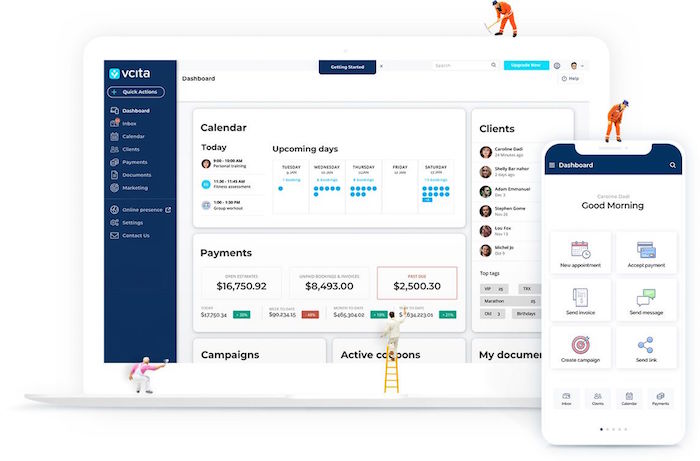The COVID-19 pandemic has taken charge. People are afraid. Cities are in lockdown. And everyone’s paranoid. Bing bang boom — your business will surely head for the gutters, right?
Wrong!
Here’s the deal: you have the capability to give your business an upward trajectory right this very moment.
You can thrive, get more customers than you can handle, and even expand your business. You just need to run the right strategies. (Well, you need to have a positive and opportunity-seeking mindset, too.)
Investing in customer relationships, for example, is one of the best strategies you can pursue. Establishing meaningful relationships with your customers will bring short- and long-term benefits, so you can never go wrong with it.
You can influence your customers to keep on buying now. And develop your relationship to such a meaningful level that they’ll stick with you for the long-haul.
To help you build long-lasting relationships with your customers, we’ll cover several tips in this guide.
1. Use a reliable business management app
Running a business isn’t exactly a walk in the park. You need to manage your clients, set meetings, send invoices, keep everyone aligned on expectations, and more.
With all the hoops and hurdles involved in running a small business, you are bound to spend countless hours shifting from one online tool to another to get things done. What’s more, some of your tasks are likely to fall through the cracks because of how full your plate is.
Don’t rely on keeping a mental count of your list of to-do’s. And keep your tech stack as consolidated as possible, so you can avoid the friction involved with jumping from one platform to another.
If you want to run your SMB efficiently, you need a reliable business management app. With a robust platform to manage your business, you can run your operations (or at least most of it) from a single platform. vcita, for example, has solutions for lead capture, email and SMS automation, client portals, invoicing, billing, scheduling appointments and more. This makes the whole process of managing a business a lot less overwhelming.

For example, you can use vcita’s contact management tools to search your customer database for people who haven’t booked consultations with you in over three months and offer them a bulk discount if they pre-pay for a bundle of services at once. This is a great way to strengthen existing relationships and to keep the conversions flowing at the same time.
With a business management app, you can have a holistic view of your business process from a single place, allowing you to supervise and run the entire process efficiently.
2. Offer top-notch customer support
Companies with less-than-stellar customer support are most likely to see higher rates of customer churn.
On the other hand, those who provide excellent support consistently are often patronized by their buyers for years. Not just that, customers even take the time to write lengthy “you are awesome” social posts about the company, which is essentially free marketing.
Regardless of the industry you’re in, you can’t go wrong with investing more in providing top-notch customer support. It makes your customer feel valued. It makes your brand look good. And it influences your customers to refer more buyers to your store.
To provide excellent support, consider installing a live chat function on your website. That way, when your customers have questions, they can use your live chat to receive an immediate reply. Using a platform like MobileMonkey, you can set up multi-channel chat, including on-site chatbots for free.
Here are a few more ways to provide better customer support:
- Create a resource page. That way, your customers can obtain the information they need immediately even without reaching out to you.
- Use social listening tools. Regardless of where your customers will pose their questions about your brand, you can learn about their inquiry if you’re using a social listening tool.
- Use chatbots. Sometimes the questions your customers ask are very straightforward. They might be about your pricing, what your refund policy is, or if you have a special promo that’s currently running. Instead of having someone answer this same inquiry, again and again, use a chatbot instead. That way, your customers’ inquiries are answered immediately. And you (or your customer support agent) can address more complex customer inquiries.
3. Produce helpful content
When you provide helpful content, you make your customers’ lives better. Their problems are solved. They avoid one frustrating experience after another. And if you played your cards right, you might even put a smile on their faces.
All of which can help you build long-lasting relationships with them.
If you’re new in the content creation scene and you’re unsure (or completely unaware) of how to find content topics that your audience will find useful, then focus on answering as many of their questions as you can.
To gain additional insight into what your customers’ burning questions are, visit your competitors’ frequently asked questions (FAQs) pages.
Visit the FAQ pages of your top ten competitors then start writing all of the questions listed. As you examine one competitor website to the next, you’ll uncover some questions that you haven’t thought of that are über-relevant.
Once you have several questions on your list, start creating a blog post for each of them. You can also categorize the questions or bundle them together based on relevance then start writing a blog post that covers multiple questions, as opposed to one question only.
Another way to uncover your customers’ questions is to view Google’s suggestions. If you’re selling online courses on how to make money online, for example, see what you’ll find in Google’s suggestions.
By using the strategies we listed, you can come up with highly-relevant, let alone useful, content topics in no time.
What’s next?
“Is the transaction the reason for the relationship? Or is the relationship the reason for the transaction?” Both questions are often asked by marketers and business owners. The latter is the sweet spot, of course. It’s what you want to build towards.
When your customers keep on buying because you have such a well-established relationship, your competitors won’t be able to steal them.
Simon Sinek once said (and I’m just paraphrasing, here): repeat business isn’t the same as customer loyalty. The former is when customers buy from you more than once. The latter is more meaningful. It’s when your customers still choose to buy from you even though your competitors offer cheaper, or even better, products.
Can you imagine how much you’d benefit if your customers stuck with you through thick and thin?
Find a Home-Based Business to Start-Up >>> Hundreds of Business Listings.

















































